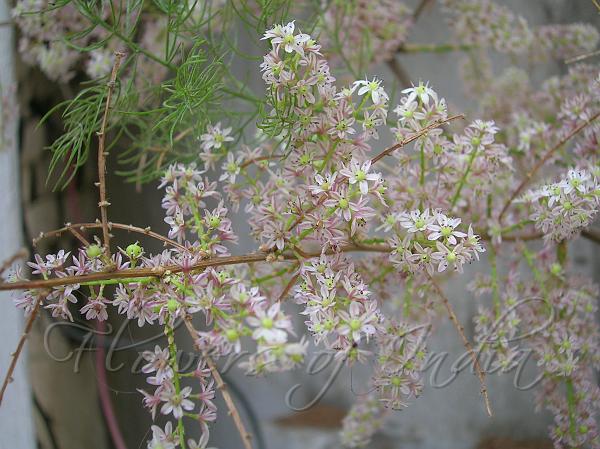|
| Satawari |
|

|

| File size | 1011635 |
| Original date | 11/18/07 1:33 PM |
| Resolution | 2048 x 1536 |
| Flash | Flash did not fire, auto |
| Focal length | 8.0mm |
| Exposure time | 1/82s |
| Aperture | 3.2 |
| Focus Distance | |
| Metering Mode | Partial |
| Camera make | NIKON |
| Camera model | E3700 |
| Sensor type |
|
|
|
|
Photo: |
Botanical name: Asparagus racemosus Family: Asparagaceae (Asparagus family)
Synonyms: Asparagopsis abyssinica, Asparagus zeylanicus, Asparagus stachyoides
Synonyms: Asparagopsis abyssinica, Asparagus zeylanicus, Asparagus stachyoides
Satawari is a woody climber growing to 1-2 m in
height, with leaves like pine needles, small and uniform and the
flowers white, in small spikes. It contains adventitious root system
with tuberous roots. Stems are climbing, branched, up to 2 m; branches
usually distinctly striate-ridged. Leaves are just modified stems,
called cladodes. Branches contain spines on them. Inflorescences
develope after cladodes, axillary, each a many-flowered raceme or
panicle 1-4 cm. Pedicel 1.5-3 mm, slender, articulate at middle.
Flowers are white with a pink tinge, 2-3 mm, bell-shaped with 6 petals.
Stamens equal, ca. 0.7 mm; anthers yellow, minute. Within India, it is
found growing wild in tropical and sub-tropical parts of India
including the Andamans; and ascending in the Himalayas up to an
altitude of 1500 m. Flowering: October-November.
Medicinal uses: In Ayurvedic medicine, the
root of Satavari is used in the form of juice, paste, decoction and
powder to treat intrinsic haemorrhage, diarrhoea, piles, hoarseness of
voice, cough, arthritis, poisoning, diseases of female genital tract,
erysipelas, fever, as aphrodisiac and as rejuvinative.
In Ayurvedic medicine, the
root of Satavari is used in the form of juice, paste, decoction and
powder to treat intrinsic haemorrhage, diarrhoea, piles, hoarseness of
voice, cough, arthritis, poisoning, diseases of female genital tract,
erysipelas, fever, as aphrodisiac and as rejuvinative.
Medicinal uses:
 In Ayurvedic medicine, the
root of Satavari is used in the form of juice, paste, decoction and
powder to treat intrinsic haemorrhage, diarrhoea, piles, hoarseness of
voice, cough, arthritis, poisoning, diseases of female genital tract,
erysipelas, fever, as aphrodisiac and as rejuvinative.
In Ayurvedic medicine, the
root of Satavari is used in the form of juice, paste, decoction and
powder to treat intrinsic haemorrhage, diarrhoea, piles, hoarseness of
voice, cough, arthritis, poisoning, diseases of female genital tract,
erysipelas, fever, as aphrodisiac and as rejuvinative. | Identification credit: Nandan Kalbag | Photographed in Delhi & Anamalai Tiger Reserve, Tamil Nadu. |
• Is this flower misidentified? If yes,